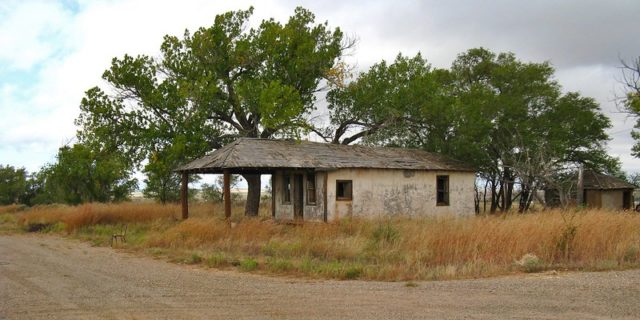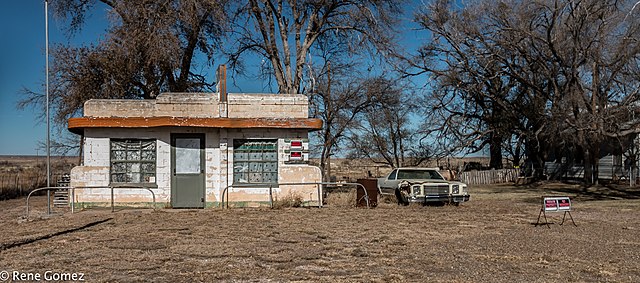There are numerous ghost towns across the United States, but few are few as interesting as Glenrio. Located along the border separating New Mexico and Texas, it serviced those traveling along US Route 66, and while never surpassing more than 30 residents was relatively successful. However, the advent of the country’s interstate system quickly led to the town’s demise.
Glenrio: A railroad and farmer town
In 1901, numerous railroads were constructed in an area along the Texas and New Mexico border, in Deaf Smith and Quay counties. Two years later, the Chicago, Rock Island and Pacific Railroad formally established the town of Rock Island – later known as Glenrio.


Cattle farmers were invited to settle in the area in 1905, and for a while the town was primarily populated by large cattle ranches. As time went on, the land soon became a place where large fields of sorghum and wheat were planted. When Glenrio began to experience an uptick in tourists via the Ozark Trail in 1917, more structures were built, and residents started moving to the area. Despite this, its population never surpassed a few dozen.
By 1920, Glenrio had a hardware store, a land office and a hotel, as well as service stations, cafés and grocery stores. It even had its own newspaper – the Glenrio Tribune – which ran from 1910 to 1934.


Due to its unusual location along the border of Texas and New Mexico, the town had quite a few strange customs, largely to avoid different government regulations. As gas taxes were higher in New Mexico, all of Glenrio’s service stations were in Texas, while its bars were located in New Mexico, as Texas was a dry state. As well, while the post office was located on the New Mexico side of the border, all the mail was dropped off at the Texas railroad depot.
US Route 66 brings about tourism
In the 1930s, the Ozark Trail was turned into US Route 66, a paved, two-lane road that connected much of the Southwestern United States. As Glenrio was nestled directly between Amarillo and Tucumcari, it quickly became a stopping point for motorists traveling long distances, leading to the opening of new businesses.


Soon, the town was filled with new motels, diners and service stations, including a Texaco station, where cars lined up for hours, and the Little Juarez Café. Both were built using the Art Moderne architectural style, which was prevalent during the 1950s.


Along with being a stop for motorists, Glenrio also became a Hollywood filming spot. The 1940 film, The Grapes of Wrath, filmed a scene along its road, and in 2018 the opening scene of Daylight’s End was shot there, despite the town having been abandoned for decades.
Bonus fact: It was also used as a model for Radiator Springs, a town featured in the Disney movie, Cars!
The construction of I-40 leads to decline
Glenrio began to experience a steep decline following the closure of the Chicago, Rock Island and Pacific Railroad depot in 1955. However, what really hit the town hard was the construction of Interstate 40 in the mid-1970s, which bypassed the area. Unlike Route 66, which was a scenic route, I-40 was intended to bring motorists to their destinations as quickly as possible, meaning fewer tourists stopped in Glenrio.


By the mid-1980s, only two residents remained in the town, and the post office was the only business still in operation. However, before long, the pair moved away and the post office closed, turning Glenrio into a ghost town.
Glenrio turns into a ghost town
In 2007, the National Register of Historic Places listed the Glenrio Historical Districted on its website, including 12 buildings and four other structures. A year later, the state of New Mexico opened the Glenrio Visitor Center along I-40, which includes information kiosks, a livestock corral, a movie theater and a pet walk. Built to accommodate around one million visitors per year, it features many eco-friendly features, including the recycling of greywater and a wind turbine.


More from us: Santa Claus, Arizona: The Tourist Town Where Christmas Dreams Go To Die
Today, all that remains of Glenrio are a small number of structures, all of which have largely begun to decay in the southern sun. The Texaco service station remains along the side of Route 66 – albeit in a derelict state – and the Little Juarez Café and the State Line Motel still grace the skyline. Depending on which side of Route 66 you drive on, you’re met with a sign that reads “First in Texas” or “Last in Texas.”
